![]()
![]()
![]()
![]()
![]()
![]()
![]()
![]()
![]()
![]()
![]()
![]()
![]()
Archives
& Museum Informatics
158 Lee Avenue
Toronto, Ontario
M4E 2P3 Canada
info@ archimuse.com
www.archimuse.com
|
|
Search A&MI |
Join
our Mailing List.
Privacy.
Published: March 15, 2001.

Production and Practical use of Astronomical 3D CG on the Web and Planetarium
Katsuhiro Mouri, Masao Suzuki, Manabu Noda Nagoya City Science Museum, Takami Yasuda, Shigeki Yokoi, Nagoya University, Japan
Abstract
The authors have been studying the role of 3-dimensional computer graphics (3D CG) for web pages of scientific museums. Since 1993, we have particularly focused on astronomical phenomena to produce 3D CG animation based on scientific or observation data. By collaborative works with specialists of several fields such as calculating of orbit of solar-system's body, making computer graphics, and Astronomy education on planetarium, we could produce high quality scientific visualization animation.
In the past, 4 collaborative works were developed as follows, The Leonids, The comet Hale-Bopp, The Saturn Ring Crossing, and The comet Shoemaker-Levy 9's collision with Jupiter. These works were effectively used for live style explanations on planetarium of Nagoya City Science Museum (NCSM), web site of NCSM and Nagoya University(NU), and TV news and science programs around the nation.
In this paper, we propose a new style of scientific museum on the web by using 3DCG and interactive function by visitors. In addition, we will show the important role of cross field collaborations of specialists for producing meaningful digital contents. We are now preparing the next subject: The small bodies of solar system.
INTRODUCTION
The Internet has increasingly become popular in homes and schools in Japan. Therefore, education on the Internet is very important now and in the near future. In Astronomy education, there are many tentative works that use Internet technology(Proc. of the Misato International Symposium,1998). An illustrative example is Okyudo and his "Observatory"(Misato), which has provided many live relays of astronomical phenomena over the Internet.(Okyudo,1998) His works are applications that show astronomical images through the Internet. The Yokohama science center is yet another example of a traditional group developing applications with astronomical data both in and out the Internet. (http://www.city.yokohama.jp/yhspot/ysc/index2.html).
In spite of all the digital on-line efforts, the most important and attractive things for most museums are their real contents. Therefore, we promote the scientific understanding of a phenomenon by connecting the experience on the Internet to it in real nature. For example, a good web site not only shows its photographs of planets and stars, but also shows what happened and how to find that object with your eye or your telescope. In Nagoya city science museum's astronomical information site (http://www.ncsm.city.nagoya.jp/astro/astro.html), we make educational contents about many astronomical events. We also make many planetarium-shows and hold many star parties(Mouri 1995, Mouri 1997, Kitahara 1998, Noda 1999).
Wherecomplicated 3-dimensional computer graphics are needed to explain astronomical phenomena, one can not make good contents only by oneself. Making contents through collaborations of many other field's specialists is effective. The purpose of this study is to consider basic applications to produce attractive and high level contents with cross field collaborations. Also we can use the high level contents in various educational forms. Our 4 works were used in our Planetarium show, on the WEB page, VHS video tape for classroom, on TV news and science special program, etc.
In this paper, we study to make 3-dimensional computer graphics that shows the mechanism of the astronomical phenomena, the way of looking it and the scientific visualization of it. We also study effective presentation way on the Web and others. In this sense we aim at the applications of new technology and new communication tools to make attractive and educational contents for the Internet and for the digital museum.
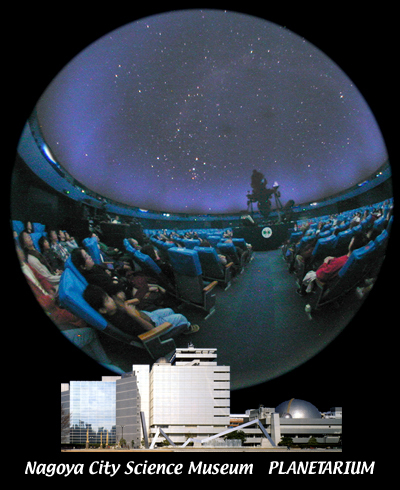
Figure 1, Nagoya City Science Museum Planetarium
COLLABORATIONS
In our collaborative works, we have 3 groups. All members are specialists from each field: Solar system orbits calculation, Computer graphics and Astronomy education in Planetarium. Our relationship is similar to the group of making movie films. The original worker is specialist of calculating. He also investigates final works on scientific view points. The camera operator and effect maker are specialists of computer-graphics. The scenario writer and the director are education specialists. If one person tries to make movie films, he has to study all about making movie films and he has to do all roles by himself. If he wants to make high quality movie film, it is difficult and hard way. Our collaborations are the same. Each group consists of specialists on their field. For example, the solar system's orbital data is calculated based on NASA's ephemeris and considered all planet's and the Sun's gravity. So the orbital data itself is high level research's result. Also the programming is the same. We use OpenGL and C language for programming and we don't use applications for 3-D animation. If we want only beautiful computer graphics, we should use these applications. But we need the scientific visualization based on scientific data. So how to create the real dimensions into the graphics workstations by using OpenGL and C language is our group's research. In Nagoya City Science Museum, we have about 300,000 visitor per year. That is No. one in Japan. We explain every live planetarium show ourselves. So we know what is of easy understand for the visitor and what is not. Also we know what is impressive for visitors in planetarium's situation. If someone wants to study all about our skills and techniques, it seems to be impossible. Therefore the cross field collaborations are valid and efficient to producing what we want.
From another view point, our collaborations are joints of each regular business and regular study. So the work by our collaborations is valuable for each field as result of own researches, returns of researches results to the public, and educational resources. So our collaborations have no money payments each other, no order each other. We think our collaborations are pure cross field collaborations.
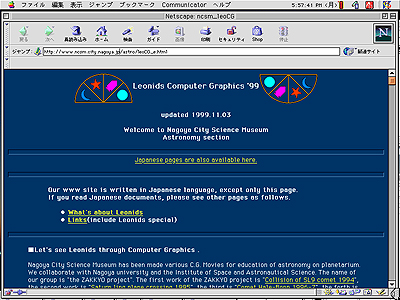
Figure 2, The Leonids C.G. WEB page
PROCEDURE OF VISUALIZATION
Our three group's (the orbit, the C.G., the planetarium) offices are in different places in Japan. So we communicate through the Internet by e-mail and web pages for discussion. Now we show procedure of the collaborations on recent our work, "the Leonids C.G."
Planning
Until now, we have produced C.G. about 1 work per year. Last year, after we discussed what interesting astronomical event to work with, we decided to make C.G. about the Leonids that is the meteor shower that happens only once per 33 years. Having the Leonids meteor shower in Japan was a historical event of the 20 century. The meteor shower's mechanism is interesting and by using 3-D view points through our computer graphics, its understanding was easy.
Sharing the making basic data
The planetarium group made an outline image of this C.G.. We shared the work on each specialty field by e-mail. The orbit group began to calculate the orbital data. The C.G. group began to make basic routine on OpenGL by C language. The planetarium group began to collect the information about the Leonids, and plan each scene's image.
Making computer graphics
Using FTP through the Internet, the orbital data, planet's texture data, catalogue data of stars, other parts of C.G. were gathered to graphics workstation at the C.G. group. The C.G. group started the programming. Before finishing the work, we checked the images on web pages, and discussed many times.
Images to C.G. movie
The C.G. group have made about 10,000 images using graphics workstation (SGI,Indigo2). These images are 640 * 480 pixels sequential data for 30 frames per second true color movie. Using FTP, the images were moved to the non linear video editing system at the planetarium. We edited and completed the images to the movie with original music.
Preview and improvement
The completed C.G. movies were previewed in planetarium dome. Also we presented the movies to visitors and watched their response. We checked, discussed and improved the movie.
Open to the public
We opened the works to the public at the planetarium and at the our Web site, at the meetings of astronomical and informatics society. Also we offered the works requests from the mass media, other planetaria, observatories, universities, schools.
EXAMPLES OF COLLABORATIONS
In the past, we produced 4 collaborative works as follows.
The Leonids C.G. (Mouri 1999, Noda 1999, Yamamoto 1999)
In a 33 year cycle, many meteor showers occur on November. These are called The Leonids. On march 1998, the comet Tempel-Tuttle returned and passed descending node. So we expected the meteor shower from 1998 to 2001. In this work, we have 3 scene as follows.
Leonids from space
Figure 2 is distant view of solar system and orbit of comet Tempel-Tuttle (an ellipse orbit). The CG's view point goes to the descending node.
Figure 3 is the scene of comet Tempel-Tuttle crossing the
descending node, on March 1998. On November 17-18, the Earth crosses the
descending node and we can see the Leonids.
Figure 4 shows the Earth passing the orbit of the comet Tempel-Tuttle once again in 1999. At that time, comet Tempel-Tuttle was far away from the descending node.
Figure 5 is the close up view near the Earth at November 17,1999 4:00am(JST). The Earth is crossing meteor particle tube. The particles from right side of the screen flow about 42km per second. The Earth moves about 30km per second from left to right on the screen. Eastern Asia looks to the upper stream of meteor particle. Figure 6 shows the Leonids radiant and the Earth from space. We can see the meteor particle spread from the radiant. It's radiant is different position to be seen from the Earth. Because the Earth moves about 30km per second around the Sun. This is "The Space Leonids".
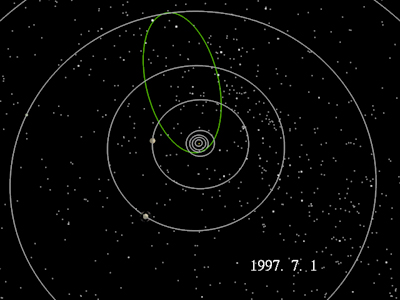
Figure 3. Distant view of solar system
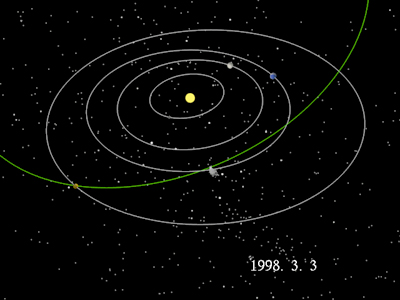
Figure 4. Comet Tempel-Tuttle crossed the descending node

Figure 5. The Earth passes descending node in 1999

Figure 6. Close up view near the Earth
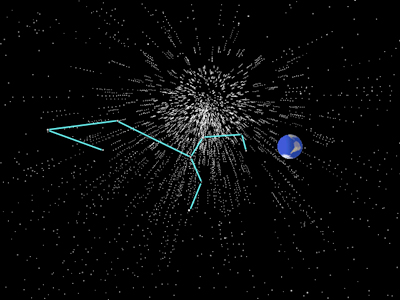
Figure 7. The Space Leonids
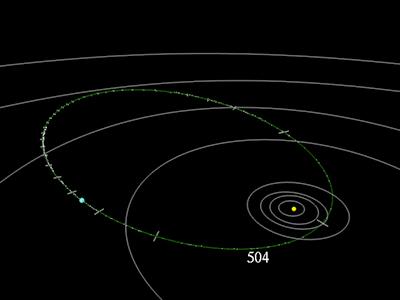
Figure 8. The particles spread along the orbit
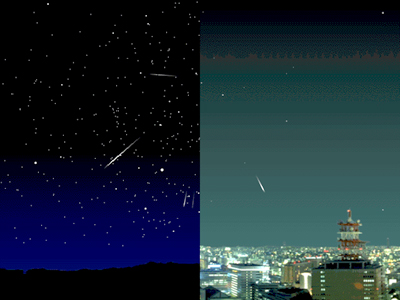
Figure 9. The Leonids meteor in comparison under ideal and urban condition
of the night sky

Figure 10. The table of density of particles and results (H.R.)
Simulation of meteor particles diffusion
Comets are made by ice and particles of rock material. When comets come close to the Sun, ice melt and particles are discharged. If those particles flow into the Earth's atmosphere, they become meteor. The particle's discharge speed is one thousandth of the comet's orbital speed. On this simulation, we set the particle's speed 12m per second. When the comet gets close to the Sun (inner Mars orbit), the comet discharges particles to all directions. The Faster particle has outer and longer orbit than the comet. In this way, the particles come to descending node after the comet. The slower particles have inner and shorter orbit. So the particles come to descending node before the comet. The disk on right center is the Sun, the other disk moving around the Sun is the comet Tempel-Tuttle, white dots are meteor particles discharged from comet nucleus. The Number is years from start.
Simulation of the Leonids as shooting stars
In this simulation, the particles that were discharged from the comet scattered as some spatial density. The particle comes into the Earth's atmosphere, flashes, and disappears and counted by program. The parameters are as follows.
-
Flashing-altitude
120km-80km (-3,-2,-1 mag.)
110km-80km (0 mag.)
100km-80km (1,2,3,4 mag) - Flashing-time
0.75second, Typical flash pattern of meteor. - Brightness
-3 - 4 mag. Luminous function is 1.5
we consider the distance from observer to
the meteor to know the real brightness. - Density of particles and results (Figure 9)
Under urban condition, the H.R. (Hourly Rate) decreases 1/3, but only darker meteors cannot be seen. So in the case of great shower, the urban condition is not so bad.
The comet Hale-Bopp C.G.(Mouri 1997, Hayashi 1997, Kitahara 1998)
In 1996-7, we had a big comet that could be seen with the naked eye. We had planed this C.G. before the comet become bright enough to see from the Earth. We visualized the comet's tail. Comets have two type tails. The one is ion tail. The another is dust tail. The ion tail is easy to draw. Because it spreads out straight to the opposite side of the Sun. But the dust tail shows more complicated shape. So we simulated the dust tails shape before we saw real tail by calculating the Sun's light pressure and the orbital motion of each particle discharged from the comet's nuclear. Figure 10 shows a distant view the comet Hale-Bopp and the inner planets. The date is when the comet reaches the periherion. Figure 11 is a scene of evening sky, the comet and it's two different shaped tails. At this work, we made interactive web pages using Java and CGI technology. So people can know the comet's position on the night sky at any time.
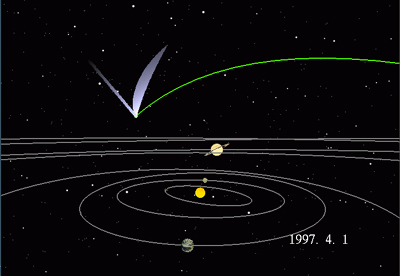
Figure 11,Distant view the comet Hale-Bopp
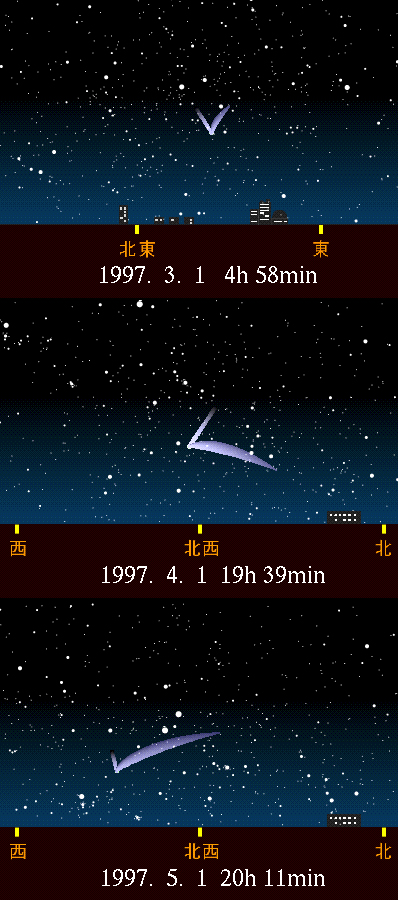
Figure 12,The comet from the Earth
The Saturn ring crossing C.G. (Kato 1995)
In 1995, after 15 year's interval, the Earth and the Sun crossed the ring plane of the Saturn. So just at that very moment, we could not see the Saturn's ring at all. In one season, the phenomenon of the ring's disappearance occurs 4 times. One is caused by the Sun's crossing the ring plane, the others are the Earth's crossing. Figure 12-14 shows the disappeareance the ring from various view points.

Figure 13 Saturn's ring plane crossing on Feb. 1 1995
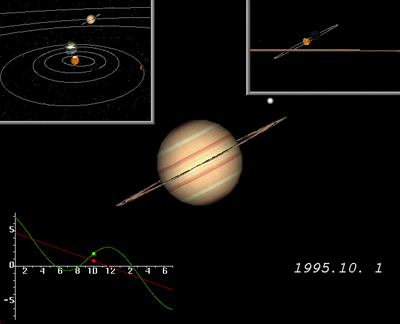
Figure 14 Saturn's ring plane crossing on Oct. 1 1995

Figure 15 Saturn's ring plane crossing on Nov. 19 1995
(just crossing day)
The comet Shoemaker-Levy 9 collision with the Jupiter C.G. (Mouri 1995, Tokai 1995)
The Comet Shoemaker-Levy 9 (SL9) collided with Jupiter in July 1994, and many people throughout the world were fascinated by this remarkable event. These C.G. shows the orbital motions of SL9. We calculated the positions of SL9 for the 100 year period prior to the collision, and produced a visual representation using the latest graphics workstation. The motion of the comet can be seen from many different angles(Figure 15,16).
Figure 17 is the comet's complex motion seen from the earth. Figure 13 shows the motion of SL9 the final 2 cycles before the collisions. It is seen from the vernal equinox. The motion of SL9 is frozen for a short time on July 7, 1992. Then SL9 was crushed by the centrifugal force and tidal force of Jupiter, and it was split about 20 small comets. The line of nuclei increased dramatically. In the box left under, the orbit of SL9 and Jupiter are drawn in the same scale in order to compare them.

Figure 16, THE HELIOCENTRIC ORBIT of SL9

Figure 17, View from above the Jupiter

Figure 18, View from the Earth
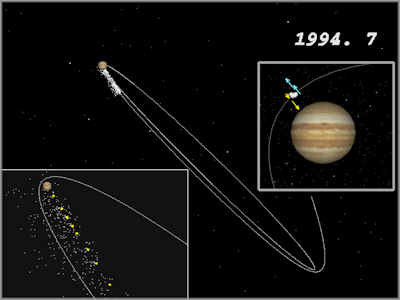
Figure 19, Crushing of SL9 and the Collisions
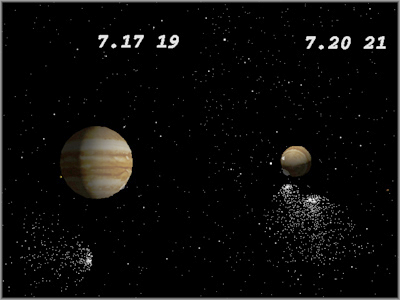
Figure 20, Each nuclei of SL9 collisions with Jupiter
PRACTICAL USE at the Planetarium and the Star-party
In each case, we made the works by collaborations for using the planetarium shows at the Nagoya City Science Museum(Mouri 1999, Mouri 2000). The Nagoya City science Museum change it's planetarium shows every month. Until now, we used our work in 7 planetarium shows.
-
1994. 7 "Great Impact on Jupiter"
- 1995. 8 "Disappear the Saturn's ring"
- 1996.10 "Wanderer of the Solar system"
- 1997. 3 "Great comet coming"
- 1998. 8 "The shooting star to the Earth"
-
1998.11 "Looking forward the meteor shower"
-
1999.10 "Again the Leonids meteor shower"
As a result, more than 200,000 visitors saw our works and heard our live explanation using these C.G.. In our planetarium, we have a multi-image system that consists of 4 video projectors, 4 betacam player, image control and processor. Also we have a 40ch multi-sound acoustic effect system. So people who come to the planetarium can experience a powerful image show. We used the works in the Star-parties in our science museum. On a night of the comet Hale-Bopp's star-party, more than 3,000 visitors participated and experienced from our C.G..

Figure 21, Lecture at the Star-party
PRACTICAL USE on the WEB and more
We also used these contents actively through the Internet. At the beginning of our project, we displayed the still pictures on the web pages. In 1998,1999, we took part in the large scale Internet project "Live Leonids". Its purpose was to show the Leonids meteor shower through the Internet to the world. At that time, we displayed our C.G. movie by realvideo and Quicktime 4 streaming. Now we displayed these C.G. movie's files on mpeg and Quicktime format to download.

Figure 22, The comet Hale-Bopp and planets on the Web

Figure 23, The comet Hale-Bopp from the Earth on the Web
On the case of comet Hale-Bopp in 1997, we made interactive pages using Shockwave and CGI. At first, people can see the outline of the comet's motion by Shockwave movie. Then, they go into the CGI pages. In that pages, they can select many parameters to see the comet(Figure 21,22). The page shown in figure 22 was particularly useful for many people, because they wanted to see the great comet through their own eyes. Most astronomical observatory opened a lot of comet's photograph on their website. Again, we think what is attractive is understanding the scientific phenomena by connecting the experience on the Internet to its real nature.
As a matter of fact, the web pages we developed under these projects had become very popular. For example, in November 1999, our Leonids web pages had more than 800,000 hits per 20 days. Mass media paid much attention to our work. In the case of the Leonids, our C.G. was used in more than 45 TV program. All key stations in Japan include NHK asked to rent and use our C.G. on their program. In classroom on universities and high schools, our C.G. was used for education. About 200 sets of the SL9 C.G. and 100 sets of the Leonids C.G. were used in Japan and the other countries.
FINALLY
In this study, we achieved large-scale and effective education by using our works on planetaria, public observatories, classrooms, mass media and on the WEB. These results show how valid and efficient cross field collaboration is in order to produce high quality scientific visualization animation on astronomical data.
We hope that such cross field's collaboration will be applied to other fields of education.
ACKNOWLEDGMENT
The authors would like to thank Dr. Makoto Yoshikawa for calculating the orbital data for our C.G. and advice for our research. We also wish to thank Mr.Takashi Yamada and Miss Masako Kitahara for useful guidance and advice. Thanks also Mr.Toshinori Ohkouchi for wonderful music. We thank to Dr. Shogo Tokai, Mr. Mistuaki Kato, Mr. Makoto Hayashi, Mr.Akihiro Yamamoto, Mr. Mitsuyoshi Terazawa for programing until the midnight. We express sincere appreciation to all participant. We acknowledge the Hori Information Science Promotion Foundation.
REFERENCES
Book:
"Educational Activities Using the Internet at Misato Observatory", Proc. of the Misato International Symposium 1998 on Astronomical Education with the Internet, 1998
Chapter in a Book:
Masami Okyudo(1998), "Educational Activities Using the Internet at Misato Observatory",Proc. of the Misato International Symposium 1998 on Astronomical Education with the Internet, pp.61-66
Journal Article:
Katsuhiro Mouri, Masao Suzuki, Masako Kitahara(1995), "Documentary the collision of comet Shoemaker-Levy 9 with Jupiter",Nagoya City Science museum bulletin Vol.21, pp.64-75,(in Japanese)
Katsuhiro Mouri, Masao Suzuki, Manabu Noda, Masako Kitahara(1997), "Practical use of Internet and Computer graphics at the Planetarium - In 1997, Comet Hale-Bopp -,Journal of Japan Information Culture Society Vol.4, No.1, pp. 69-75(in Japanese, abstract in English)
Masako Kitahara, Katsuhiro Mouri, Masao Suzuki, Manabu Noda, Shunji Hattori,Hiromi Maeda(1998), "Comet Hale-Bopp and Nagoya City Science Museum", Nagoya City Science museum bulletin Vol.24,pp.66-72, (in Japanese)
Manabu Noda, Katsuhiro Mouri, Masao Suzuki,Masako Kitahara(1999), "Leonids98 and Nagoya City Science Museum", Nagoya City Science museum bulletin Vol.25,pp.30-35(in Japanese)
Akihiro Yamamoto, Takami Yasuda, Shigeki Yokoi, Masako Kitahara,Katsuhiro Mouri, Manabu Noda, Masao Suzuki,Makoto Yoshikawa,Takashi Yamada, Toshinori Ohkouchi(1999), "Development of the Visualization System for the Meteor Streams and CG simulation of the Leonids," Computer Visualization Symposium '99, pp.53-56,(in Japanese)
Makoto Hayashi, Takami Yasuda, Shigeki Yokoi(1997), "An Interactive Educational System for Astronomy on the Internet", Technical Report of IEICE, MVE96-68, pp.1-8,(in Japanese, abstract in English)
Mitsuaki Kato, Takami Yasuda, Shigeki Yokoi(1995), "CG Simulation of Space Phenomena - The Vanishing Rings of Saturn -, NICOGRAPH 1995, pp.171-178,(in Japanese)
Shogo Tokai, Takami Yasuda, Shigeki Yokoi, Jun-ichiro Toriwaki(1995), "A Method of Expression of Space Phenomena with CG Animation: the Collision of the Comet Shoemakaer-Levy 9 with Jupiter in JUly 1994, Computer Graphics: Developments in Virtual Environments,pp.267-280, Academic press,1995
Katsuhiro Mouri, Masako Kitahara, Takami Yasuda, Shigeki Yokoi(1999), "Production and practical use of teaching materials based on 3-dimensional computer-graphics technology with collaboration in education of astronomy", Technical Report of IEICE, ET99-22, pp.9-16,(in Japanese, abstract in English)
Katsuhiro Mouri,Masao Suzuki,Manabu Noda, Takami Yasuda, Shigeki Yokoi(2000):Production and Practical Use of teaching Materials Based on 3-dimensional Computer-graphics Technology with Collaborations in Education of Astronomy, International Workshop on Advanced Image Technology, 2000.1.13-14
